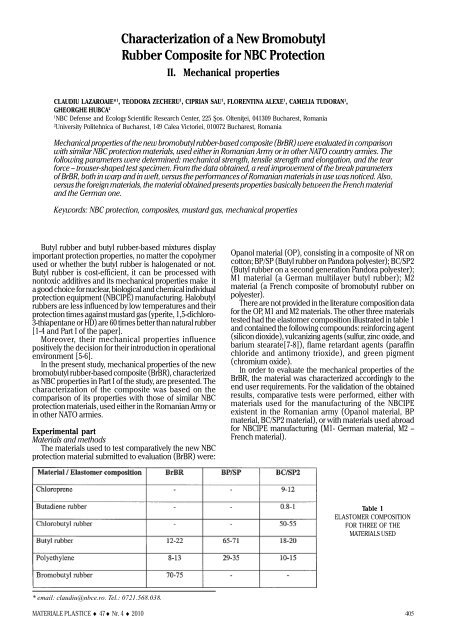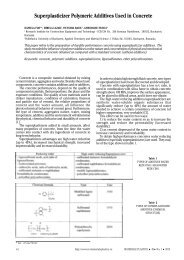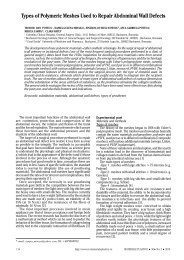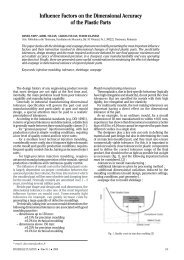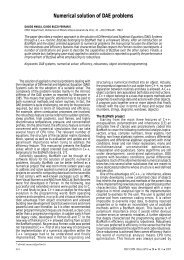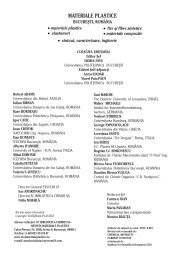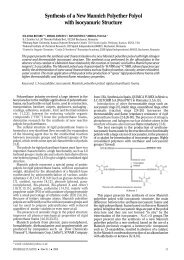LAZAROAIE C - revista de materiale plastice
LAZAROAIE C - revista de materiale plastice
LAZAROAIE C - revista de materiale plastice
Create successful ePaper yourself
Turn your PDF publications into a flip-book with our unique Google optimized e-Paper software.
Characterization of a New Bromobutyl<br />
Rubber Composite for NBC Protection<br />
II. Mechanical properties<br />
CLAUDIU <strong>LAZAROAIE</strong>* 1 , TEODORA ZECHERU 1 , CIPRIAN SAU 1 , FLORENTINA ALEXE 1 , CAMELIA TUDORAN 1 ,<br />
GHEORGHE HUBCA 2<br />
1<br />
NBC Defense and Ecology Scientific Research Center, 225 ªos. Olteniþei, 041309 Bucharest, Romania<br />
2<br />
University Politehnica of Bucharest, 149 Calea Victoriei, 010072 Bucharest, Romania<br />
Mechanical properties of the new bromobutyl rubber-based composite (BrBR) were evaluated in comparison<br />
with similar NBC protection materials, used either in Romanian Army or in other NATO country armies. The<br />
following parameters were <strong>de</strong>termined: mechanical strength, tensile strength and elongation, and the tear<br />
force – trouser-shaped test specimen. From the data obtained, a real improvement of the break parameters<br />
of BrBR, both in warp and in weft, versus the performances of Romanian materials in use was noticed. Also,<br />
versus the foreign materials, the material obtained presents properties basically between the French material<br />
and the German one.<br />
Keywords: NBC protection, composites, mustard gas, mechanical properties<br />
Butyl rubber and butyl rubber-based mixtures display<br />
important protection properties, no matter the copolymer<br />
used or whether the butyl rubber is halogenated or not.<br />
Butyl rubber is cost-efficient, it can be processed with<br />
nontoxic additives and its mechanical properties make it<br />
a good choice for nuclear, biological and chemical individual<br />
protection equipment (NBCIPE) manufacturing. Halobutyl<br />
rubbers are less influenced by low temperatures and their<br />
protection times against mustard gas (yperite, 1,5-dichloro-<br />
3-thiapentane or HD) are 60 times better than natural rubber<br />
[1-4 and Part I of the paper].<br />
Moreover, their mechanical properties influence<br />
positively the <strong>de</strong>cision for their introduction in operational<br />
environment [5-6].<br />
In the present study, mechanical properties of the new<br />
bromobutyl rubber-based composite (BrBR), characterized<br />
as NBC properties in Part I of the study, are presented. The<br />
characterization of the composite was based on the<br />
comparison of its properties with those of similar NBC<br />
protection materials, used either in the Romanian Army or<br />
in other NATO armies.<br />
Experimental part<br />
Materials and methods<br />
The materials used to test comparatively the new NBC<br />
protection material submitted to evaluation (BrBR) were:<br />
Opanol material (OP), consisting in a composite of NR on<br />
cotton; BP/SP (Butyl rubber on Pandora polyester); BC/SP2<br />
(Butyl rubber on a second generation Pandora polyester);<br />
M1 material (a German multilayer butyl rubber); M2<br />
material (a French composite of bromobutyl rubber on<br />
polyester).<br />
There are not provi<strong>de</strong>d in the literature composition data<br />
for the OP, M1 and M2 materials. The other three materials<br />
tested had the elastomer composition illustrated in table 1<br />
and contained the following compounds: reinforcing agent<br />
(silicon dioxi<strong>de</strong>), vulcanizing agents (sulfur, zinc oxi<strong>de</strong>, and<br />
barium stearate[7-8]), flame retardant agents (paraffin<br />
chlori<strong>de</strong> and antimony trioxi<strong>de</strong>), and green pigment<br />
(chromium oxi<strong>de</strong>).<br />
In or<strong>de</strong>r to evaluate the mechanical properties of the<br />
BrBR, the material was characterized accordingly to the<br />
end user requirements. For the validation of the obtained<br />
results, comparative tests were performed, either with<br />
materials used for the manufacturing of the NBCIPE<br />
existent in the Romanian army (Opanol material, BP<br />
material, BC/SP2 material), or with materials used abroad<br />
for NBCIPE manufacturing (M1- German material, M2 –<br />
French material).<br />
Table 1<br />
ELASTOMER COMPOSITION<br />
FOR THREE OF THE<br />
MATERIALS USED<br />
* email: claudiu@nbce.ro. Tel.: 0721.568.038.<br />
MATERIALE PLASTICE ♦ 47♦ Nr. 4 ♦ 2010 405
The tests were performed using standard apparatus and<br />
standardized methods in or<strong>de</strong>r to avoid any difference<br />
resulted from the method or testing equipment used.<br />
Determination of the mechanical strength<br />
A James H. Heal dynamometer, mo<strong>de</strong>l TITAN 710,<br />
coupled with a Genius Fini compressor of 8 bars, was used<br />
for the tests. The apparatus works un<strong>de</strong>r the following<br />
parameters: 3000 N ± 1% maximum tensile strength, and<br />
operation system between +5 ÷ +45 °C [9-10].<br />
Determination of tensile strength and elongation of the<br />
textile materials<br />
Two sets of samples were taken from each material,<br />
one on the warp direction and the other on the weft<br />
direction. No sample taken on the warp direction should<br />
contain the same longitudinal threads and no sample taken<br />
on the weft direction should contain the same threads.<br />
Every set contains five samples of 50 mm 0.5 mm width<br />
and a length enough to allow a distance between the<br />
clamps of 200 mm ± 1 mm, accordingly to [11].<br />
The samples were set and pretensioned with 5 N for<br />
materials with weight between 200 and 500 g/m 2 and 10<br />
N for materials with weight > 500 g/m 2 . The clamp<br />
movement was set to a constant rate of 100 mm/min ±<br />
10 mm/min.<br />
The tests results where the samples sli<strong>de</strong><br />
asymmetrically or over 2 mm along the fixing line were<br />
exclu<strong>de</strong>d.<br />
Maximum break force and elongation at break were<br />
recor<strong>de</strong>d and the mean value on each direction for the five<br />
samples was calculated. The values obtained were<br />
roun<strong>de</strong>d to 1 N or 1 %.<br />
The mean values of the elongation at maximum break<br />
force and elongation at break were calculated. The values<br />
obtained are roun<strong>de</strong>d as following: 0.2% for elongations<br />
8%; 0.5% for elongations between 8 and 50%; 1% for<br />
elongations > 50%.<br />
Fig. 1. Warp tensile strength and elongation at break<br />
406<br />
MATERIALE PLASTICE ♦ 47♦ Nr. 4 ♦ 2010
Determination of tear force – trouser-shaped test specimen<br />
Two sample sets of five samples were taken, one on<br />
the warp direction and the other one on the weft direction.<br />
Any two samples should not contain the same longitudinal<br />
or transverse threads and should not be cut from less than<br />
150 mm of the material edge [12-13].<br />
The sampling length of the apparatus is set at 100 mm,<br />
and the elongation rate at 100 mm/min.<br />
The following parameters were marked: the tear force<br />
- in Newtons, the tear trajectory, perpendicular or not on<br />
the stress direction, whether the threads sli<strong>de</strong>, instead of<br />
breaking.<br />
Results and discussions<br />
Tensile strength and elongation at break<br />
The elongation at break and tensile strength values are<br />
given in figures 1-4.<br />
Fig. 2. Weft tensile strength and<br />
elongation at break<br />
Fig. 3. Comparative results on the materials tensile strength in warp (a) and in weft (b)<br />
MATERIALE PLASTICE ♦ 47♦ Nr. 4 ♦ 2010 407
Fig. 4. Comparative results on the materials elongation at break in<br />
warp (a) and in weft (b)<br />
Fig. 5. Comparative results on the materials tear strength in warp<br />
(a) and in weft (b)<br />
Fig. 6. Warp tear strength<br />
408<br />
MATERIALE PLASTICE ♦ 47♦ Nr. 4 ♦ 2010
Fig. 7. Weft tear strength<br />
From the data obtained it can be noticed a real<br />
improvement of the break parameters of BrBR, both in warp<br />
(1390.34 N), and in weft (1364 N), versus the performances<br />
of Romanian materials in use (429.37, 810.24, and 772.73<br />
in warp, and 241.63, 497.77, and 506.27 in weft).<br />
Also, versus the foreign materials, the material obtained<br />
is basically between the French material (681.96 N and<br />
449.51 N) and the German one (2424.39 and 2294.27 N).<br />
As regarding the elongation at break, it cannot be<br />
observed a significant improvement of this parameter. In<br />
the condition of a good mechanical resistance, this is a<br />
less significant operational parameter.<br />
Tear force<br />
The values obtained during tests using trouser-shaped<br />
method are presented in figures 5-7.<br />
From the results obtained it can be noticed that BrBR<br />
offers a three time improvement in tear strength (46.20<br />
and 49.57, respectively) versus Romanian materials in use<br />
(16.87, 11.98 and 16.34 N; and 16.18, 10.39 and 17.07 N,<br />
respectively).<br />
In comparison with the foreign materials, the composite<br />
obtained is similar to the French material (12.45, and 45.08<br />
N, respectively), but strictly inferior to the German material<br />
(86.70, and 109.27 N, respectively).<br />
Conclusions<br />
Mechanical properties of the new bromobutyl rubberbased<br />
composite (BrBR) were evaluated in comparison<br />
with similar NBC protection materials, used either in<br />
Romanian Army or in other NATO armies: mechanical<br />
strength, tensile strength and elongation, and the tear force<br />
– trouser-shaped test specimen.<br />
A real improvement of the break and tear strength<br />
parameters of BrBR, both in warp and in weft, versus the<br />
performances of Romanian materials in use was noticed.<br />
Also, versus the foreign materials, the material obtained<br />
presents properties basically between the French material<br />
and the German one. No improvement was noticed,<br />
though, regarding the elongation at break.<br />
References<br />
1. OHM, R.F., Rubber World, 219, 1998, p. 5.<br />
2. IVAN, G., GIURGINCA, M., Materiale Plastice, 34, 1997, p. 134.<br />
3. JIPA, S., GIURGINCA, M., SETNESCU, T., SETNESCU, R., IVAN, G.,<br />
MIHALCEA, I., Polym. Degrad. Stab., 54, 1996, p. 1.<br />
MATERIALE PLASTICE ♦ 47♦ Nr. 4 ♦ 2010 409
4. TSOU, A.H., DUVDEVANI, I., DATTA, S., J. Appl. Polym. Sci., 102,<br />
2006, p. 4447.<br />
5. LÃZÃROAIE, C., Revista Agenþiei <strong>de</strong> Cercetare pentru Tehnicã ºi<br />
Tehnologii Militare, 2-3, 2000, p. 75.<br />
6. *** AEP-38. NATO Allied Engineering Publication “Operational<br />
requirements, technical specifications and test procedures and<br />
evaluation criteria for NBC protective clothing”, Ed.1, 1993.<br />
7. WADDELL, W.H., NAPIER, R.C., TRACEY, D.S., ROUCKHOUT, D.F.,<br />
KARMARKAR, U., Rubber World, 238, 2008, p. 21.<br />
8. RODGERS, B., SOLIS, S., TAMBE, N., SHARMA, B.B., Rubber Chem.<br />
Technol., 81, 2008, p. 600.<br />
9. DREERMAN, E., NARKIS, M., SIEGMANN, A., JOSEPH, R., DODIUK,<br />
H., DIBENEDETTO, A.T., J. Appl. Polym. Sci., 72, 1999, p. 647.<br />
10. SUDHA, T.B., THANIKAIVELAN, P., AARON, K.P., KRISHNARAJ, K.,<br />
CHANDRASEKARAN, B., J. Appl. Polym. Sci., 114, 2009, p. 1761.<br />
11.*** EN ISO 1421:2002 Rubber – or plastics coated – fabrics.<br />
Determination of tensile strength and elongation at break<br />
12. *** ISO 13937-2:2001 Textiles - Tear properties of fabrics - Part 2:<br />
Determination of tear force of trouser-shaped test specimens (Single<br />
tear method)<br />
13. VRIJHOEF, M.M., LOURENS, F.L., LEYDEKKERSGOVERS, G.F., J.<br />
Oral Rehabilit., 13, 1986, p. 325<br />
Manuscript received: 24.06.2010<br />
410<br />
MATERIALE PLASTICE ♦ 47♦ Nr. 4 ♦ 2010


